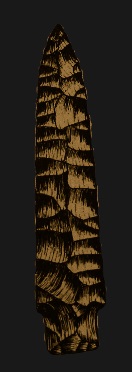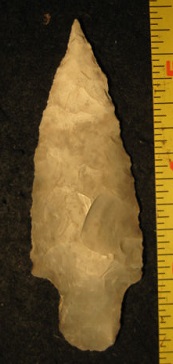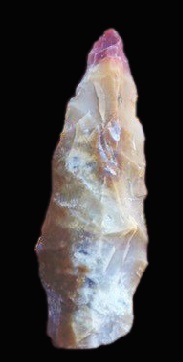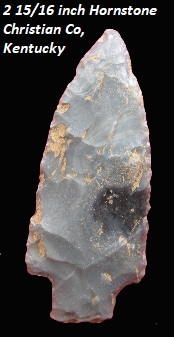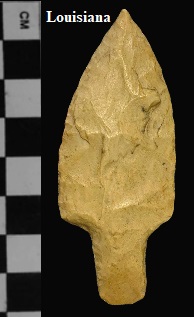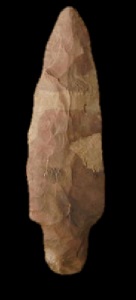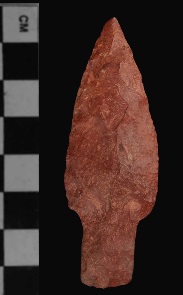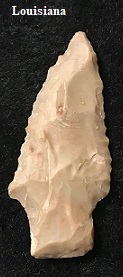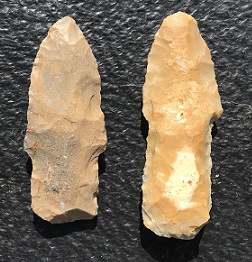Name Details:
Named By: James A. Ford and Clarence H. Webb
Named For: Lake in Louisiana
Date Identified: 1956
Type Site: Poverty Point, West Carol Parish. Louisiana
Pontchartrain Type I
Cluster:
Commonly Utilized Material:
Tan cherts are the most common material followed by
locally available materials.
Date:
Cultural Period:
3,500 - 2,000 B.P.
Late Archaic to Woodland
Neoglacial to Roman Warm
Glacial Period:
Culture:
Outline is Representative of Size and Shape:
Description of Physical Characteristics and Flaking Pattern:
This is a thick
narrow medium to
large stemmed point with an median ridge or diamond shaped cross section.
A median ridge may be present on one or both faces with the other
face being flat. The blade is narrow commonly being 3 time the
length as the width and is primarily excurvate, but many examples may have a pentagonal appearance being excurvate towards the
tip and having parallel sides. The shoulders are horizontal to having an upward slope. The stem is primarily straight, but
may vary to slightly contracting. The base may vary from straight to slightly convex.
A well executed ripple flake generally extends from the edge to the
face, however some examples have pressure flaking used to retouch
the edges forming a random flaking
pattern.
Size Measurements: Total Length
- 48 to 110 mm (average 60 to 80 mm), Stem Length - 10 to 20 mm, Blade Width -
20 to 35 mm (average 25 to 30 mm), Stem Width - 13 to 18 mm
Distribution:
Distribution Comments:
This point is primarily found in the lower Mississippi River valley, Red River valley, and the Tennessee River valley.
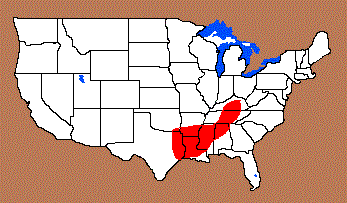
Related / Associated Points:
Additional Comments:
The Pontchartrain Type II point has a smaller distribution than the Type I point does. The Pontchartrain Type I generally has a longer narrower blade than the Type
II point. In addition, the shoulders of the Type I are horizontal to having an upward slope. The base of the Type I is also stem
is commonly wider and squarer and commonly has the cortex rind on the basal edge. The Type I may have a noticeable twist to the blade which is not commonly seen with the
Type II point.
Perino (1968) lists the type I as the Pontchartrain Typical and the Type II
as Pontchartrain Corner Notch.
The Flint Creek point may be an extension of the Pontchartrain type with the Flint Creek point having an expanding stem while the Pontchartrain points tend to have a straight stem or slightlly contracting stem (MaGahey, 2000).
Other points in this Cluster:
Point Validity: Valid Type
Ford is an archaeologist who cataloged the cultures of the lower Mississippi River valley. He is most
noted for conducting the first large scale excavation at Poverty Point. Webb was a trained Pediatrician who became interested in archeology. In 1940 he became the charter member of
the Society of American Archeology. He conducted many collaborative excavations and conducted his own excavations at Poverty Point and Gahagan Mounds. He was a well-respected archeologist. He named this point in a
professional publication and this type has many professional references. This is a valid
.
Age Details:
References: (See Reference Page, Entry Number):
8,
23, 30, 179, 216, W11
Pontchartrain Projectile Point, Pontchartrain Arrowhead
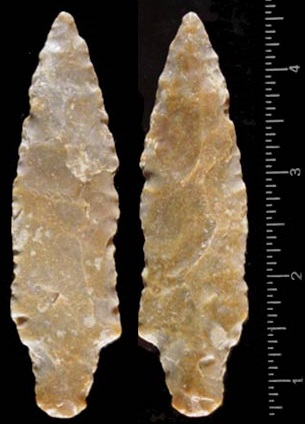

.jpg)
